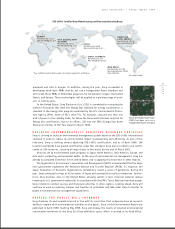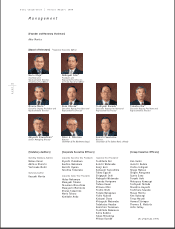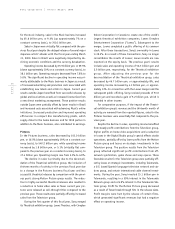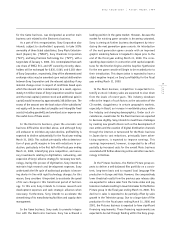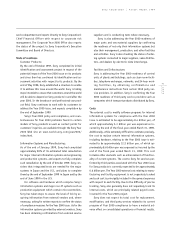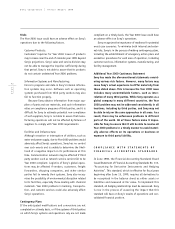Sony 1999 Annual Report Download - page 37
Download and view the complete annual report
Please find page 37 of the 1999 Sony annual report below. You can navigate through the pages in the report by either clicking on the pages listed below, or by using the keyword search tool below to find specific information within the annual report.
Sony Corporation Annual Report 1999
35
page
Sony is promoting the development of next generation
flat displays. Sony is co-developing large flat-panel dis-
plays using plasma-addressed liquid crystal (PALC) tech-
nologies based on an agreement entered into in July
1997 with Philips Electronics N.V. in the Netherlands
and Sharp Corporation. In October 1998, Sony entered
into an agreement with Candescent Technologies Inc. in
the U.S. to jointly develop high-voltage Field Emission
Displays (FED) for next generation flat-panel computer
displays. In addition, Sony made a further capital infu-
sion during the year in ST-LCD. ST-LCD was jointly
established between Sony and Toyoda Automatic Loom
Works, Ltd. in order to manufacture the next generation
of LCD panels, and started manufacturing such LCD panels
in April 1999.
In the “Electronic components and other” category,
sales decreased by 78.4 billion yen, or 10.1% (down
approximately 15% on a constant currency basis), to
696.5 billion yen. The significant decline in sales is prin-
cipally due to weak sales of semiconductors and elec-
tronic components including CRTs for computer displays.
Semiconductor sales declined, principally in Asia, due
to a decision to shrink the memory business, which had
low profit margins, and to weak sales of signal process-
ing LSI devices for video CD players and other applica-
tions. Financial performance worsened because the
reduced sales heightened the impact of depreciation of
production equipment. Sales and operating income of
CRTs for computer displays also deteriorated, principally
in Europe, due to increased price competition and weak
demand. Sales of lithium-ion batteries rose due to grow-
ing demand for notebook PCs, while profitability dete-
riorated due to such factors as downward pressure on
market prices.
As a strategy for next generation semiconductors, Sony
started cooperative work with Fujitsu Limited in develop-
ing and manufacturing 0.18 micron meter generation
system LSI under an agreement made in June 1998.
Game
The Game business continued to achieve overall favorable
results both in PlayStation game consoles and software. Sales
increased by 61.3 billion yen, or 8.5% (up approximately
7% on a constant currency basis), to 783.8 billion yen.
In Japan, despite strong sales of software, total sales
declined by 52.7 billion yen, or 16.5%, from the previous
fiscal year due to slowing sales of game consoles as a result
of such factors as the high penetration ratio of game con-
soles among Japanese households. On the other hand, in
the U.S. and Europe, sales increased by 100.9 billion yen, or
27.7% (up approximately 26% on a constant currency
basis), as aggressive pricing strategies and increases in soft-
ware titles resulted in further demand for game consoles
and software.
Worldwide production shipments of game consoles were
21.60 million units for the year compared with 19.37 mil-
lion units in the previous fiscal year, resulting in cumula-
tive shipments of 54.42 million units as of March 31, 1999.
With respect to software, worldwide production shipments
(including both Sony and third parties under Sony licenses)
were 194 million units for the year compared with 138 mil-
lion units in the previous fiscal year, resulting in cumula-
tive shipments of 430 million units as of March 31, 1999.
Operating income increased by 19.6 billion yen, or 16.7%
(up approximately 11% on a constant currency basis), to
136.5 billion yen. Operating margin rose from 16.2% to
17.4%. Advertising expenses increased due to aggressive
advertising and promotion aiming for further expansion of
sales. In addition, research and development expenses in-
creased by 10.0 billion yen, or 250%, to 14.0 billion yen,
principally for the development of the next generation of
game console. However, despite these cost increases, a sub-
stantial increase in profit was achieved because of sales
expansion in the U.S. and Europe.
For future business development, Sony Computer Enter-
tainment (“SCE”) has substantially completed its co-
development with Toshiba Corporation of new technology,
comprising the 128 bit CPU dubbed the “Emotion Engine”.
In order to process graphic information at maximum speeds,
its data bus, cache memory, and all registers are 128 bit
and are integrated on a single chip of LSI. SCE and Toshiba
Corporation agreed upon establishment of a joint venture
company to produce the Emotion Engine. Also, SCE has
developed a Graphics Synthesizer incorporating a massive
parallel rendering engine. SCE plans capital expenditures
totaling approximately 120 billion yen in the next two years
to permit volume production of these new technologies.
Music
During the year, the Music business excluding Japan achieved
record results in terms of sales, operating income, market
share, and chart share, despite weak performance in the
Brazilian market. Despite a flattening in worldwide growth




